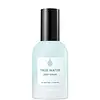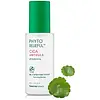What's inside
What's inside
 Key Ingredients
Key Ingredients

 Benefits
Benefits

 Concerns
Concerns

No concerns
 Ingredients Side-by-side
Ingredients Side-by-side

Water
Skin ConditioningPentylene Glycol
Skin ConditioningGlycerin
HumectantMethyl Gluceth-20
HumectantMethylpropanediol
SolventBis-PEG-18 Methyl Ether Dimethyl Silane
EmollientPiper Methysticum Leaf/Root/Stem Extract
Skin ConditioningDioscorea Japonica Root Extract
Skin ConditioningArctium Lappa Root Extract
Skin ConditioningPhellinus Linteus Extract
Skin ConditioningAloe Barbadensis Leaf Extract
EmollientPortulaca Oleracea Extract
Skin ConditioningPueraria Thunbergiana Root Extract
Skin ConditioningGlycyrrhiza Glabra Root Extract
BleachingPaeonia Lactiflora Root Extract
Skin ConditioningCnidium Officinale Root Extract
Skin ConditioningSoluble Collagen
HumectantAloe Barbadensis Leaf Juice
Skin ConditioningHydrogenated Lecithin
EmulsifyingSodium Hyaluronate
HumectantButylene Glycol
HumectantTromethamine
BufferingAcrylates/C10-30 Alkyl Acrylate Crosspolymer
Emulsion StabilisingXanthan Gum
EmulsifyingAdenosine
Skin ConditioningHydrolyzed Corn Starch
HumectantSodium Polyacrylate
AbsorbentPvm/Ma Copolymer
Emulsion StabilisingPolyquaternium-51
Skin ConditioningGlycosyl Trehalose
Emulsion StabilisingBeta-Glucan
Skin ConditioningHydrogenated Starch Hydrolysate
HumectantRaffinose
Skin ConditioningBiosaccharide Gum-1
HumectantSucrose
HumectantInositol
HumectantPanthenol
Skin ConditioningLecithin
EmollientFolic Acid
Skin ConditioningCeramide NP
Skin ConditioningCholesterol
EmollientPalmitoyl Pentapeptide-4
Skin ConditioningPEG/PPG/Polybutylene Glycol-8/5/3 Glycerin
HumectantPEG-40 Hydrogenated Castor Oil
EmulsifyingParfum
Masking1,2-Hexanediol
Skin ConditioningCI 42090
Cosmetic ColorantLimonene
PerfumingWater, Pentylene Glycol, Glycerin, Methyl Gluceth-20, Methylpropanediol, Bis-PEG-18 Methyl Ether Dimethyl Silane, Piper Methysticum Leaf/Root/Stem Extract, Dioscorea Japonica Root Extract, Arctium Lappa Root Extract, Phellinus Linteus Extract, Aloe Barbadensis Leaf Extract, Portulaca Oleracea Extract, Pueraria Thunbergiana Root Extract, Glycyrrhiza Glabra Root Extract, Paeonia Lactiflora Root Extract, Cnidium Officinale Root Extract, Soluble Collagen, Aloe Barbadensis Leaf Juice, Hydrogenated Lecithin, Sodium Hyaluronate, Butylene Glycol, Tromethamine, Acrylates/C10-30 Alkyl Acrylate Crosspolymer, Xanthan Gum, Adenosine, Hydrolyzed Corn Starch, Sodium Polyacrylate, Pvm/Ma Copolymer, Polyquaternium-51, Glycosyl Trehalose, Beta-Glucan, Hydrogenated Starch Hydrolysate, Raffinose, Biosaccharide Gum-1, Sucrose, Inositol, Panthenol, Lecithin, Folic Acid, Ceramide NP, Cholesterol, Palmitoyl Pentapeptide-4, PEG/PPG/Polybutylene Glycol-8/5/3 Glycerin, PEG-40 Hydrogenated Castor Oil, Parfum, 1,2-Hexanediol, CI 42090, Limonene
Water
Skin ConditioningCentella Asiatica Extract
CleansingGlycerin
HumectantPropanediol
SolventMethyl Gluceth-20
Humectant1,2-Hexanediol
Skin ConditioningNiacinamide
SmoothingPolyglycerin-3
HumectantMethylpropanediol
SolventPentylene Glycol
Skin ConditioningSolanum Melongena Fruit Extract
Skin ConditioningLonicera Japonica Flower Extract
Skin ConditioningForsythia Suspensa Fruit Extract
AntioxidantAngelica Gigas Root Extract
Skin ConditioningCnidium Officinale Root Extract
Skin ConditioningGardenia Jasminoides Fruit Extract
Cosmetic ColorantCoptis Japonica Root Extract
Skin ConditioningGlycyrrhiza Uralensis Root Extract
Skin ConditioningLaminaria Japonica Extract
Skin ProtectingEclipta Prostrata Leaf Extract
Skin ConditioningHouttuynia Cordata Extract
Skin ConditioningUlmus Davidiana Root Extract
Skin ConditioningAmaranthus Caudatus Seed Extract
Skin ConditioningSodium Hyaluronate
HumectantHydrogenated Lecithin
EmulsifyingButylene Glycol
HumectantXanthan Gum
EmulsifyingAcrylates/C10-30 Alkyl Acrylate Crosspolymer
Emulsion StabilisingAdenosine
Skin ConditioningSodium Polyacrylate
AbsorbentPvm/Ma Copolymer
Emulsion StabilisingTromethamine
BufferingFructooligosaccharides
HumectantBeta-Glucan
Skin ConditioningHydrolyzed Hyaluronic Acid
HumectantHydroxyacetophenone
AntioxidantEthylhexylglycerin
Skin ConditioningWater, Centella Asiatica Extract, Glycerin, Propanediol, Methyl Gluceth-20, 1,2-Hexanediol, Niacinamide, Polyglycerin-3, Methylpropanediol, Pentylene Glycol, Solanum Melongena Fruit Extract, Lonicera Japonica Flower Extract, Forsythia Suspensa Fruit Extract, Angelica Gigas Root Extract, Cnidium Officinale Root Extract, Gardenia Jasminoides Fruit Extract, Coptis Japonica Root Extract, Glycyrrhiza Uralensis Root Extract, Laminaria Japonica Extract, Eclipta Prostrata Leaf Extract, Houttuynia Cordata Extract, Ulmus Davidiana Root Extract, Amaranthus Caudatus Seed Extract, Sodium Hyaluronate, Hydrogenated Lecithin, Butylene Glycol, Xanthan Gum, Acrylates/C10-30 Alkyl Acrylate Crosspolymer, Adenosine, Sodium Polyacrylate, Pvm/Ma Copolymer, Tromethamine, Fructooligosaccharides, Beta-Glucan, Hydrolyzed Hyaluronic Acid, Hydroxyacetophenone, Ethylhexylglycerin
 Reviews
Reviews

Ingredients Explained
These ingredients are found in both products.
Ingredients higher up in an ingredient list are typically present in a larger amount.
1,2-Hexanediol is a synthetic liquid and another multi-functional powerhouse.
It is a:
- Humectant, drawing moisture into the skin
- Emollient, helping to soften skin
- Solvent, dispersing and stabilizing formulas
- Preservative booster, enhancing the antimicrobial activity of other preservatives
Acrylates/C10-30 Alkyl Acrylate Crosspolymer is a synthetic polymer. It is used to thicken and improve the texture of products. Due to its properties, it can prevent water and oil ingredients from separating.
Adenosine is in every living organism. It is one of four components in nucleic acids that helps store our DNA.
Adenosine has many benefits when used. These benefits include hydrating the skin, smoothing skin, and reducing wrinkles. Once applied, adenosine increases collagen production. It also helps with improving firmness and tissue repair.
Studies have found adenosine may also help with wound healing.
In skincare products, Adenosine is usually derived from yeast.
Learn more about AdenosineBeta-Glucan is a polysaccharide. It can be derived from the cell walls of seaweed, oats, yeast, and fungi. It hydrates the skin and helps boost your skin's natural barrier.
As an antioxidant, beta-glucan helps fight free-radicals. Free-radicals are molecules that may damage your skin cells, such as pollution.
Studies show this ingredient may be an effective wrinkle reducer as it can deeply penetrate into skin. It has also been show to help with wound healing.
Learn more about Beta-GlucanButylene Glycol (or BG) is used within cosmetic products for a few different reasons:
Overall, Butylene Glycol is a safe and well-rounded ingredient that works well with other ingredients.
Though this ingredient works well with most skin types, some people with sensitive skin may experience a reaction such as allergic rashes, closed comedones, or itchiness.
Learn more about Butylene GlycolWe don't have a description for Cnidium Officinale Root Extract yet.
Glycerin is already naturally found in your skin. It helps moisturize and protect your skin.
A study from 2016 found glycerin to be more effective as a humectant than AHAs and hyaluronic acid.
As a humectant, it helps the skin stay hydrated by pulling moisture to your skin. The low molecular weight of glycerin allows it to pull moisture into the deeper layers of your skin.
Hydrated skin improves your skin barrier; Your skin barrier helps protect against irritants and bacteria.
Glycerin has also been found to have antimicrobial and antiviral properties. Due to these properties, glycerin is often used in wound and burn treatments.
In cosmetics, glycerin is usually derived from plants such as soybean or palm. However, it can also be sourced from animals, such as tallow or animal fat.
This ingredient is organic, colorless, odorless, and non-toxic.
Glycerin is the name for this ingredient in American English. British English uses Glycerol/Glycerine.
Learn more about GlycerinHydrogenated Lecithin is created from the hydrogenation of lecithin (a group of phospholipids). Hydrogenation is a chemical reaction between hydrogen and another element.
This ingredient is an emollient and emulsifier. As an emollient, it helps soften skin by trapping moisture within. As an emulsifier, it prevents oil and water ingredients from separating.
Methyl Gluceth-20 is a humectant. Humectants help draw moisture from the air to your skin.
It is created by combining polyethylene glycol with glucose.
Methylpropanediol is a synthetic solvent and humectant.
As a solvent, it helps dissolve other ingredients, helping to evenly distribute ingredients throughout the product. This ingredient has also been shown to have antimicrobial properties which makes it a preservative booster.
Methylpropanediol is able to add a bit of moisture to the skin. It also helps other ingredients be better absorbed into the skin, such as salicylic acid.
Learn more about MethylpropanediolPentylene glycol is typically used within a product to thicken it. It also adds a smooth, soft, and moisturizing feel to the product. It is naturally found in plants such as sugar beets.
The hydrophilic trait of Pentylene Glycol makes it a humectant. As a humectant, Pentylene Glycol helps draw moisture from the air to your skin. This can help keep your skin hydrated.
This property also makes Pentylene Glycol a great texture enhancer. It can also help thicken or stabilize a product.
Pentylene Glycol also acts as a mild preservative and helps to keep a product microbe-free.
Some people may experience mild eye and skin irritation from Pentylene Glycol. We always recommend speaking with a professional about using this ingredient in your routine.
Pentylene Glycol has a low molecular weight and is part of the 1,2-glycol family.
Learn more about Pentylene GlycolWe don't have a description for Pvm/Ma Copolymer yet.
Sodium Hyaluronate is hyaluronic acid's salt form. It is commonly derived from the sodium salt of hyaluronic acid.
Like hyaluronic acid, it is great at holding water and acts as a humectant. This makes it a great skin hydrating ingredient.
Sodium Hyaluronate is naturally occurring in our bodies and is mostly found in eye fluid and joints.
These are some other common types of Hyaluronic Acid:
Learn more about Sodium HyaluronateSodium Polyacrylate is the sodium salt of polyacrylic acid. It is used as an absorber, emollient, and stabilizer.
This ingredient is a super-absorbent polymer - meaning it can absorb 100 to 1000 times its mass in water. As an emollient, Sodium Polyacrylate helps soften and soothe skin. Emollients work by creating a barrier to trap moisture in. This helps keep your skin hydrated.
Tromethamine helps balance the pH and improve the texture of a product. It is synthetically created.
As an emulsifier, Tromethamine prevents oil and water ingredients from separating. This helps stabilize the product and elongate a product's shelf life. Tromethamine also makes a product thicker.
Tromethamine helps balance the pH level of a product. Normal pH level of skin is slightly acidic (~4.75-5.5). The acidity of our skin is maintained by our glands and skin biome. Being slightly acidic allows our skin to create an "acid mantle". This acid mantle is a thin barrier that protects our skin from bacteria and contaminants.
Oral Tromethanmine is an anti-inflammatory drug but plays the role of masking, adding fragrance, and/or balancing pH in skincare.
1,3-Propanediol, 2-amino-2-(hydroxymethyl)-
Learn more about TromethamineWater. It's the most common cosmetic ingredient of all. You'll usually see it at the top of ingredient lists, meaning that it makes up the largest part of the product.
So why is it so popular? Water most often acts as a solvent - this means that it helps dissolve other ingredients into the formulation.
You'll also recognize water as that liquid we all need to stay alive. If you see this, drink a glass of water. Stay hydrated!
Learn more about WaterXanthan gum is used as a stabilizer and thickener within cosmetic products. It helps give products a sticky, thick feeling - preventing them from being too runny.
On the technical side of things, xanthan gum is a polysaccharide - a combination consisting of multiple sugar molecules bonded together.
Xanthan gum is a pretty common and great ingredient. It is a natural, non-toxic, non-irritating ingredient that is also commonly used in food products.
Learn more about Xanthan Gum